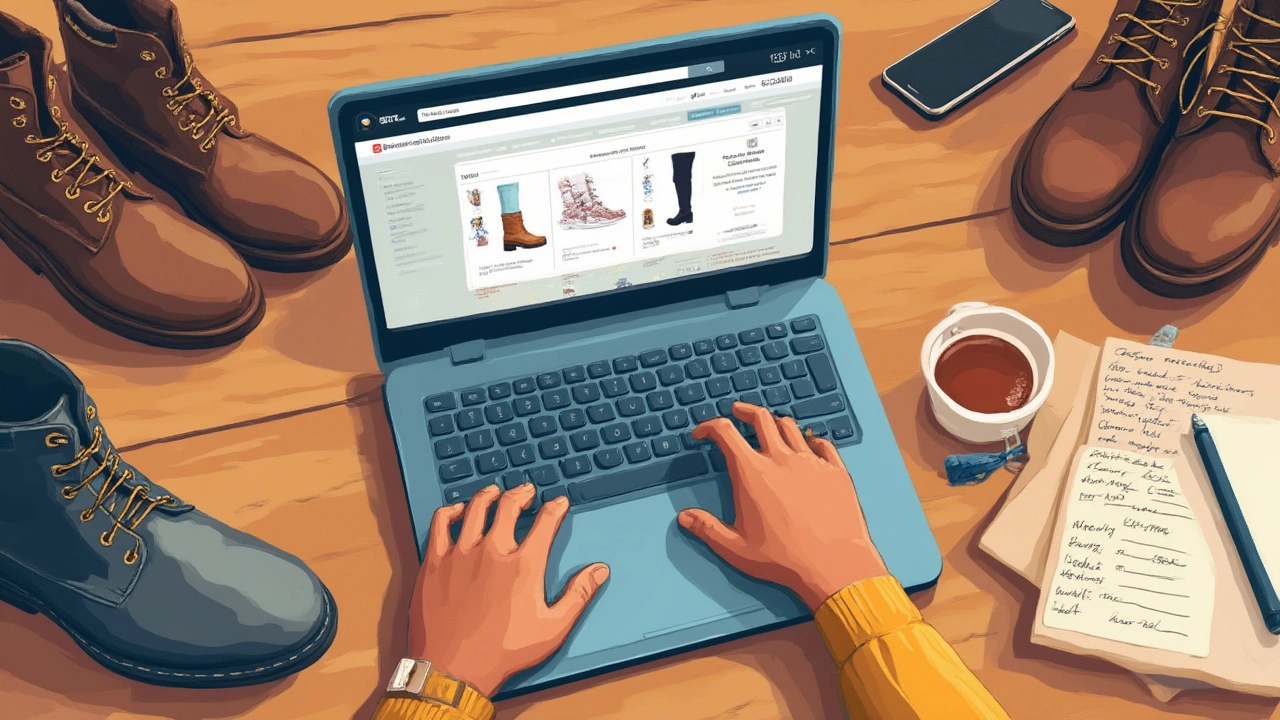Bet you’ve slipped on what seemed like the perfect pair of boots, only to find your toes squashed or your heel swimming in space. Ever wondered why your shiny new boots just don’t fit like your everyday sneakers? The answer isn’t just about the brand or style—it all comes down to the surprisingly tricky relationship between boot size and shoe size. It seems simple: you’re a size 10 in shoes, so size 10 boots should fit, right? If only it were that easy. This isn’t just a retail industry quirk. There’s real science, history, and a heap of ‘gotchas’ hiding in how footwear is sized. Let’s get right to the stuff the salespeople don’t always tell you.
Why Boot and Shoe Sizes Aren't Always the Same
Your foot doesn’t magically change shape when you swap shoes for boots. So why is sizing such a headache? The truth starts with differences in both how boots are made and how they’re worn. Shoe sizing—thanks to centuries of tradition—was designed for more basic, low-cut footwear. Boots cover and protect more of your foot and sometimes your ankle or even your calf. They often use thicker, stiffer materials, which change their internal dimensions.
Manufacturers don’t always agree on sizing either. A US size 10 in trainers may fit totally different from a UK size 10 in work boots or an EU 44 hiking boot. Even within the same country, a boot’s construction can shift things. Some boots have a narrower toe box, others run wide. Laces, zippers, and pulls all add to the mix—some let you adjust the fit easily, some mean you’re stuck with what you get.
The lining is another sneaky culprit. Brands like Red Wing and Timberland often use plush, thick materials to make boots warmer and cozier. That’s a plus in winter—unless the lining eats up valuable toe space. On the flip side, cowboy boots and certain dress boots tend to run longer and more pointed in the toe. In Clara’s words (she’s a size 8), “My boots always need more toe wiggle room than my sneakers, or my feet feel like they’ll fall asleep.” Spot on.
Don’t count on your feet staying the same size for every pair either. Age, weight, and even the time of day make your feet swell or shrink. Morning shopping? Your feet might be at their smallest. Trying boots after a long Auckland day on your feet? They’ve probably expanded. One 2022 study found most people have nearly a half-size difference between morning and evening foot measurements.
Materials, Construction, and Brands: What Really Affects the Fit?
This is where things get wild. Materials change everything. Leather stretches and molds after a few weeks—but synthetics like rubber or vinyl rarely give. If you buy sturdy work boots, expect them to feel tighter when new (especially with a steel toe or safety features woven in). Hiking boots often have reinforced areas for ankle support, adding yet more bulk inside the boot.
And then there’s the construction. Goodyear welted boots, with their classic double-stitched sole, have a chunkier profile—sometimes almost a full half-size smaller inside. Cemented or stitchdown construction may feel roomier, even at the same labeled size. Check for things like removable insoles or extra padding. Some boots toss in a thick memory foam insole that feels plush but chews up precious internal real estate.
Brand matters as much as anything. Outdoor-focused brands, like Merrell or Salomon, tend to run true to athletic shoe sizes but offer wider width options. Fashion brands (think Dr. Martens, Blundstone) are famous for their quirks—one style may fit snug, another loose, even from the same company. If you loved the fit of your old Blundstone 585s, don’t assume every other model is sized the same. Dr. Martens, for example, notoriously run large—most folks size down from their sneaker fit.
Pro tip: the more expensive or handmade the boot, the less likely “standard sizing” applies. European heritage boots often come in just whole sizes and expect you to wear thick socks, while mass-market brands stick closer to sneaker sizing. Pay close attention to customer reviews—real-world wearers love to warn about boots that pinch or slip.
And, hey—don’t forget about width. Most shoes and boots are made in a “D” (medium) width for men and “B” (medium) for women. Need something wider or narrower? Look for brands advertising EE, EEE (extra wide), or AA (narrow) options. Getting width right is just as crucial as length if you want comfort instead of blisters.

Measuring Your Feet and Reading Size Charts: Avoiding Sizing Nightmares
Want to outsmart the madness? Grab a ruler, a blank sheet of paper, and your favourite thick socks. Stand up straight with the paper under your foot (get a mate to help, or bribe your teenager with chocolates if you’re stuck solo). Mark the heel and the tip of your longest toe, then measure the distance. Repeat with both feet—yep, they really can be different sizes, and you always want to fit the larger foot.
Armed with this number, skip the sales pitch and hit the brand’s sizing chart. Don’t look at the number in your sneaker or business shoe—compare your measurement with the boot brand’s actual chart, and make sure you’re checking the right country (US, UK, or EU). Sizes might not line up perfectly, especially for boots made abroad. Some companies even say, “runs half-size large, order down”—pay attention to this!
If you’re ordering online, see if the shop offers free returns or exchanges. Try your new boots indoors first, walking around on a clean surface—some retailers won’t take them back if they’re scuffed. Wear the socks you actually plan to use with the boots. Winter boots? Use thick woollies. Fashion boots? Try with tights or thinner socks. Even a small change in sock thickness can change the fit by almost half a size.
Don’t ignore half-sizes if they’re available—the difference may seem tiny, but can mean the world to your toes after hours of wear. If you’re stuck between sizes, most fit experts suggest sizing up for boots—especially if you’re wearing them for work, hiking, or long days out, since your feet do swell.
Break-in period is a real thing. Many high-quality boots need a week or two to shape themselves to your foot. Expect a little discomfort at first, but watch for hot spots or numbness—these signs mean the boot isn’t right, no matter what the size tag says.
Working With Specialty Boots: Hiking, Work, Western, and Women's Styles
Each boot type brings its own headaches. Hiking boots need extra space for your toes to spread downhill, so most fitters recommend about a thumb’s width in front of your longest toe. For work boots—especially those with safety toes—don’t be shocked if you need to size up a half or even a full size. Those steel or composite toes aren’t nearly as forgiving as any running shoe.
Western (cowboy) boots are notorious. Pointed toes squash your toes forward, so many buyers go up a half-size from their sneakers. But, because they’re slip-on, your heel should lift just a little when you walk—not so much you slip out, but enough you can walk without friction burns. Clara picked up a pair last summer that felt weirdly loose at first, but after three outings, they fit like a glove. That’s the boot breaking in. Fitting them too tight out of the box is a recipe for crushed toes.
Women’s boots often run narrower, especially in the calf. When Clara shops, she always checks for brands with "wide calf" options—not just because she wants to fit in jeans, but for pure comfort. For fashion or dress boots, it’s smart to measure calf circumference and compare it to the brand’s size chart. Some premium brands let you choose calf sizes separately from foot size—don’t overlook this!
Kids? Those little feet grow fast, so leave a thumb’s room at the toe and check length regularly. For fast-growing teens, buying boots a half-size up is less wasteful—no one likes buying boots every three months.
Don’t forget about arch support, especially if you spend hours on your feet. Some boots come with built-in support, but not all. Swapping the insole for a quality aftermarket one can make the same-size boot feel completely different. High arches? Go for brands that boast strong midfoot support or specialized footbeds.
Boot size and shoe size just aren’t twins. They’re more like cousins—related, but different enough to matter. If you want happy feet, check sizing guides, measure often, and don’t be afraid to experiment with new fits and brands. Take your time, try boots on late in the day after you’ve walked a while, and listen to your feet. They’ll scream if you get it wrong—and you might be surprised how little that size number really means.

